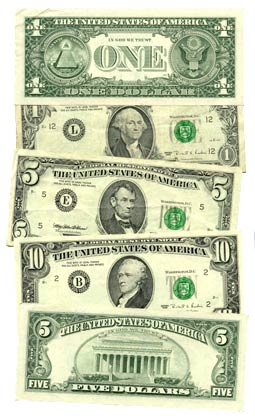 Why did the U.S. government spend 2.6 million dollars to train Chinese prostitutes to drink responsibly? Why did the U.S. government spend $175,587 “to determine if cocaine makes Japanese quail engage in sexually risky behavior”? Why did the U.S. government spend nearly a million dollars on a new soccer field for detainees being held at Guantanamo Bay? This week when I saw that the IRS was about to pay out 70 million dollars in bonuses to their employees and that the U.S. government was going to be leaving 7 billion dollars worth of military equipment behind in Afghanistan, it caused me to reflect on all of the other crazy ways that the government has been wasting our money in recent years. So I decided to go back through my previous articles and put together a list. I call it “The Waste List”. Even though our politicians insist that there is very little that can still be cut out of the budget, the truth is that the federal budget is absolutely drowning in pork. The following are 66 crazy ways that the U.S. government is wasting your hard-earned money…
Why did the U.S. government spend 2.6 million dollars to train Chinese prostitutes to drink responsibly? Why did the U.S. government spend $175,587 “to determine if cocaine makes Japanese quail engage in sexually risky behavior”? Why did the U.S. government spend nearly a million dollars on a new soccer field for detainees being held at Guantanamo Bay? This week when I saw that the IRS was about to pay out 70 million dollars in bonuses to their employees and that the U.S. government was going to be leaving 7 billion dollars worth of military equipment behind in Afghanistan, it caused me to reflect on all of the other crazy ways that the government has been wasting our money in recent years. So I decided to go back through my previous articles and put together a list. I call it “The Waste List”. Even though our politicians insist that there is very little that can still be cut out of the budget, the truth is that the federal budget is absolutely drowning in pork. The following are 66 crazy ways that the U.S. government is wasting your hard-earned money…
#1 The IRS is about to pay out 70 million dollars in bonuses to employees even though discretionary bonuses are supposed to be cancelled due to the sequester.
#2 According to the Washington Post, the U.S. government is going to leave 7 billion dollars worth of military equipment behind in Afghanistan.
#3 It is being projected that the trip that the Obamas will be making to Africa will cost U.S. taxpayers $100,000,000.
#4 The NIH plans to spend $509,840 on a study that “will send text messages in ‘gay lingo’ to methamphetamine addicts to try to persuade them to use fewer drugs and more condoms.”
#5 The National Science Foundation has given $384,949 to Yale University to do a study on “Sexual Conflict, Social Behavior and the Evolution of Waterfowl Genitalia”. Try not to laugh, but much of this research involves examining and measuring the reproductive organs of male ducks.
#6 The IRS spent $60,000 on a film parody of “Star Trek” and a film parody of “Gilligan’s Island”. Internal Revenue Service employees were the actors in the two parodies, so as you can imagine the acting was really bad.
#7 The NIH has given $1.5 million to Brigham and Women’s Hospital in Boston, Massachusetts to study why “three-quarters” of lesbians in the United States are overweight and why most gay males are not.
#8 The NIH has also spent $2.7 million to study why lesbians have more “vulnerability to hazardous drinking”.
#9 The U.S. government is giving sixteen F-16s and 200 Abrams tanks to the Muslim Brotherhood in Egypt even though the new president of Egypt, Mohammed Morsi (a member of the Muslim Brotherhood), constantly makes statements such as the following…
“Dear brothers, we must not forget to nurse our children and grandchildren on hatred towards those Zionists and Jews, and all those who support them”
#10 During 2012, the salaries of Barack Obama’s three climate change advisers combined came to a grand total of more than $370,000.
#11 Overall, 139 different White House staffers were making at least $100,000 during 2012, and there were 20 staffers that made the maximum of $172,200.
#12 Amazingly, U.S. taxpayers spend more than 1.4 billion dollars a year on the Obamas. Meanwhile, British taxpayers only spend about 58 million dollars on the entire royal family.
#13 During 2012, $25,000 of federal money was spent on a promotional tour for the Alabama Watermelon Queen.
#14 The U.S. government spent $505,000 “to promote specialty hair and beauty products for cats and dogs” in 2012.
#15 NASA spends close to a million dollars a year developing a menu of food for a manned mission to Mars even though it is being projected that a manned mission to Mars is still decades away.
#16 During 2012, the federal government spent 15 million dollars to help the Russians recruit nuclear scientists.
#17 Over the past 15 years, a total of approximately $5.25 million has been spent on hair care services for the U.S. Senate.
#18 The U.S. government spent 27 million dollars to teach Moroccans how to design and make pottery in 2012.
#19 At a time when we have an epidemic of unemployment in the United States, the U.S. Department of Education is spending $1.3 million to “reduce linguistic, academic, and employment barriers for skilled and low-skilled immigrants and refugees, and to integrate them into the U.S. workforce and professions.”
#20 The federal government still sends about 20 million dollars a year to the surviving family members of veterans of World War I, even though World War I ended 94 years ago.
#21 The U.S. government is spending approximately 3.6 million dollars a year to support the lavish lifestyles of former presidents such as George W. Bush and Bill Clinton.
#22 During fiscal 2012, the National Science Foundation gave researchers at Purdue University $350,000. They used part of that money to help fund a study that discovered that if golfers imagine that a hole is bigger it will help them with their putting.
#23 The U.S. government is giving hundreds of millions of dollars to the Palestinian Authority every single year.
#24 Federal agencies have purchased a total of approximately 2 billion rounds of ammunition over the past couple of years. It is claimed that all of this ammunition is needed for “training purposes”.
#25 During 2012, the National Science Foundation spent $516,000 on the creation of a video game called “Prom Week” which apparently simulates “all the social interactions of the event.”
#26 If you can believe it, $10,000 of U.S. taxpayer money was actually used to purchase talking urinal cakes up in Michigan.
#27 When Joe Biden and his staff took a trip to London, the hotel bill cost U.S. taxpayers $459,388.65.
#28 Joe Biden and his staff also stopped in Paris for one night. The hotel bill for that one night came to $585,000.50.
#29 If you can believe it, close to 15,000 retired federal employees are currently collecting federal pensions for life worth at least $100,000 annually. That list includes such names as Newt Gingrich, Bob Dole, Trent Lott, Dick Gephardt and Dick Cheney.
#30 The U.S. Department of Agriculture has spent $300,000 to encourage Americans to eat caviar.
#31 The National Institutes of Health recently gave $666,905 to a group of researchers that is conducting a study on the benefits of watching reruns on television.
#32 The National Science Foundation has given 1.2 million dollars to a team of “scientists” that is spending part of that money on a study that is seeking to determine whether elderly Americans would benefit from playing World of Warcraft or not.
#33 The National Institutes of Health recently gave $548,731 to a team of researchers that concluded that those that drink heavily in their thirties also tend to feel more immature.
#34 The National Science Foundation recently spent $30,000 on a study to determine if “gaydar” actually exists. This is the conclusion that the researchers reached at the end of the study….
“Gaydar is indeed real and… its accuracy is driven by sensitivity to individual facial features”
#35 In 2011, the National Institutes of Health spent $592,527 on a study that sought to figure out once and for all why chimpanzees throw poop.
#36 The National Institutes of Health has spent more than 5 million dollars on a website called Sexpulse that is targeted at “men who use the Internet to seek sex with men”. According to Fox News, the website “includes pornographic images of homosexual sex as well as naked and scantily clad men” and features “a Space Invaders-style interactive game that uses a penis-shaped blaster to shoot down gay epithets.”
#37 The General Services Administration spent $822,751 on a “training conference” for 300 west coast employees at the M Resort and Casino in Las Vegas. The following is how the Washington Post described some of the wasteful expenses that happened during this “conference”…
Among the “excessive, wasteful and in some cases impermissable” spending the inspector general documented: $5,600 for three semi-private catered in-room parties and $44 per person daily breakfasts; $75,000 for a “team-building” exercise — the goal was to build a bicycle; $146,000 on catered food and drinks; and $6,325 on commemorative coins in velvet boxes to reward all participants for their work on stimulus projects. The $31,208 “networking” reception featured a $19-per-person artisanal cheese display and $7,000 of sushi. At the conference’s closing-night dinner, employees received “yearbooks” with their pictures, at a cost of $8,130.
You can see some stunning pictures of GSA employees living the high life in Las Vegas right here.
#38 Do you remember when credit rating agency Egan Jones downgraded U.S. government debt from AA+ to AA? Well, someone in the federal government apparently did not like that at all. According to Zero Hedge, the SEC planned to file charges against Egan Jones for “misstatements” on a regulatory application with the SEC.
Normally, the SEC does not go after anyone. After all, when is the last time a major banker went to prison?
No, the truth is that the SEC is usually just a huge waste of taxpayer money. According to ABC News, one investigation found that 17 senior SEC officials had been regularly viewing pornography while at work. While the American people were paying their salaries, this is what senior SEC officials were busy doing…
One senior attorney at SEC headquarters in Washington spent up to eight hours a day accessing Internet porn, according to the report, which has yet to be released. When he filled all the space on his government computer with pornographic images, he downloaded more to CDs and DVDs that accumulated in boxes in his offices.
An SEC accountant attempted to access porn websites 1,800 times in a two-week period and had 600 pornographic images on her computer hard drive.
Another SEC accountant used his SEC-issued computer to upload his own sexually explicit videos onto porn websites he joined.
And another SEC accountant attempted to access porn sites 16,000 times in a single month.
#39 According to InformationWeek, the federal government is spending “millions of dollars” to train Asian call center workers.
#40 If you can believe it, the federal government has actually spent $750,000 on a new soccer field for detainees held at Guantanamo Bay.
#41 The U.S. Agency for International Development spent 10 million dollars to create a version of “Sesame Street” for Pakistani television.
#42 The Obama administration has plans to spend between 16 and 20 million dollars to help students from Indonesia get master’s degrees.
#43 The National Science Foundation spent $198,000 on a University of California-Riverside study that explored “motivations, expectations and goal pursuit in social media.” One of the questions the study sought an answer to was the following: “Do unhappy people spend more time on Twitter or Facebook?”
#44 In 2011, $147,138 was given to the American Museum of Magic in Marshall, Michigan. Their best magic trick is making U.S. taxpayer dollars disappear.
#45 The federal government recently spent $74,000 to help Michigan “increase awareness about the role Michigan plays in the production of trees and poinsettias.”
#46 In 2011, the federal government gave $550,000 toward the making of a documentary about how rock and roll contributed to the fall of the Soviet Union.
#47 The National Institutes of Health has contributed $55,382 toward a study of “hookah smoking habits” in the country of Jordan.
#48 The federal government gave $606,000 to researchers at Columbia University to study how heterosexuals use the Internet to find love.
#49 A total of $133,277 was recently given to the International Center for the History of Electronic Games for video game preservation. The International Center for the History of Electronic Games says that it “collects, studies, and interprets video games, other electronic games, and related materials and the ways in which electronic games are changing how people play, learn, and connect with each other, including across boundaries of culture and geography.”
#50 The federal government has given approximately $3 million to researchers at the University of California at Irvine to fund their “research” into video games such as World of Warcraft.
#51 In 2011, the National Science Foundation gave one team of researchers $149,990 to create a video game called “RapidGuppy” for cell phones and other mobile devices.
#52 In 2011, $936,818 was spent developing an online soap opera entitled “Diary of a Single Mom”. The show “chronicles the lives and challenges of three single mothers and their families trying to get ahead despite obstacles that all single mothers face, such as childcare, healthcare, education, and finances.”
#53 Last year, the federal government spent $96,000 to buy iPads for kindergarten students in Maine.
#54 The U.S. Postal Service once spent $13,500 for a single dinner at Ruth’s Chris Steakhouse.
#55 In 2011, the Air Force Academy completed work on an outdoor worship area for pagans and Wiccans. The worship area consists of “a small Stonehenge-like circle of boulders with [a] propane fire pit” and it cost $51,474 to build. The worship area is “for the handful of current or future cadets whose religions fall under the broad category of ‘Earth-based’, which includes Wiccans, druids and pagans.” At this point, that only includes 3 current students at the Air Force Academy.
#56 The National Institutes of Health once gave researchers $400,000 to study why gay men in Argentina engage in risky sexual behavior when they are drunk.
#57 The National Institutes of Health once gave researchers $442,340 to study the behavior of male prostitutes in Vietnam.
#58 The National Institutes of Health once spent $800,000 in “stimulus funds” to study the impact of a “genital-washing program” on men in South Africa.
#59 The National Science Foundation recently spent $200,000 on a study that examined how voters react when politicians change their stances on climate change.
#60 The federal government recently spent $484,000 to help build a Mellow Mushroom pizzeria in Arlington, Texas.
#61 At this point, China is holding over a trillion dollars of U.S. government debt. But that didn’t stop the United States from sending 17.8 million dollars in foreign aid to China in 2011.
#62 The U.S. Department of Agriculture gave the largest snack food maker in the world (PepsiCo Inc.) a total of 1.3 million dollars in corporate welfare that was used to help build “a Greek yogurt factory in New York.”
#63 The National Science Foundation recently gave a whopping $697,177 to a New York City-based theater company to produce a musical about climate change.
#64 The federal government once shelled out $2.6 million to train Chinese prostitutes to drink responsibly.
#65 The U.S. Department of Agriculture once handed researchers at the University of New Hampshire $700,000 to study methane gas emissions from dairy cows.
#66 The federal government has spent $175,587 “to determine if cocaine makes Japanese quail engage in sexually risky behavior”.






